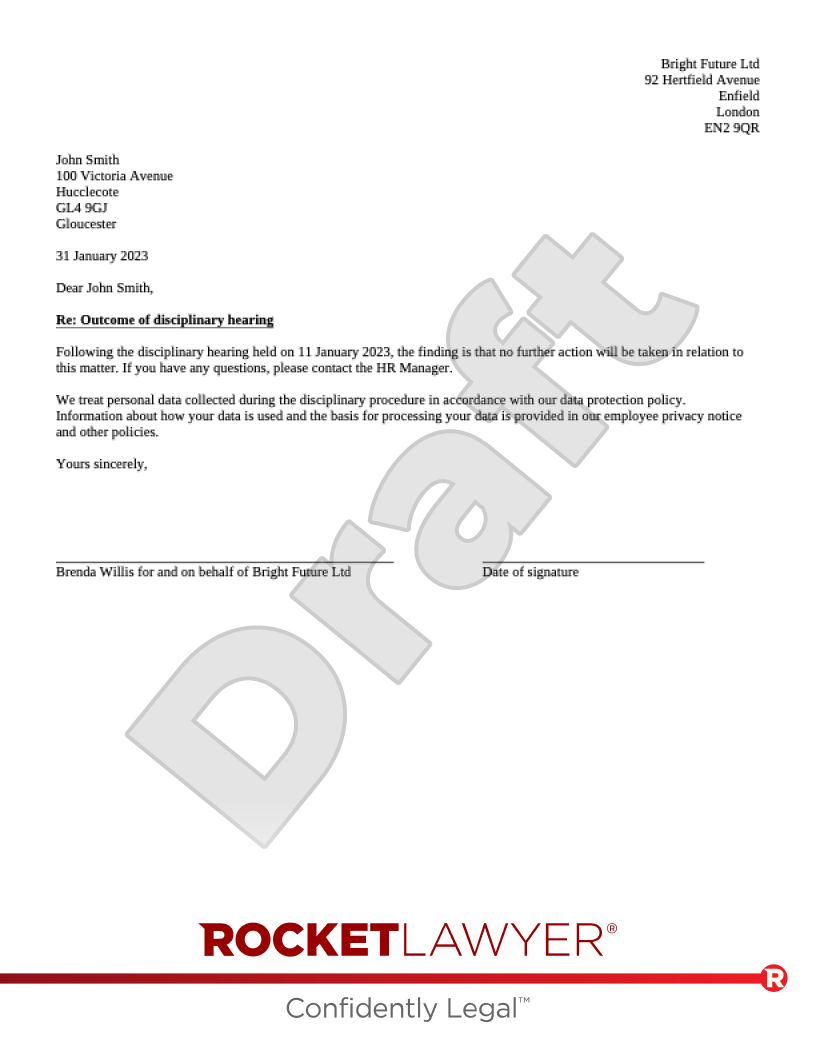Check your employment documents
Review any disciplinary arrangements set out in your policies or contracts (eg Employment contract or Zero-hours contract) and any Data protection policies you have for employees. For more information, read Data protection and employees. This note summarises the minimum standards but if your own arrangements are more generous on any point then follow that arrangement.
This guide summarises the minimum standards for disciplinary warning. However, employment policies and arrangements may be more generous and any such enhanced procedures should be followed over the required minimum.
Undertake a disciplinary process
As a first step, you should investigate any disciplinary matters (eg misconduct or poor performance). Depending on the situation and evidence available, you may consider holding a disciplinary hearing, you should reach a decision and communicate it.
For more information, read Disciplinary process.
Choosing and communicating the disciplinary decision
After the disciplinary hearing, you should reach a decision and communicate it.
For simple cases, you can confirm the decision at the end of the meeting. However, it’s often helpful to allow a day or two to reflect and deal with any follow-up queries. In these cases, it’s good practice to call another meeting to confirm the final outcome.
When you decide what penalty to apply you must consider how serious the offence was, any mitigating factors, previous similar cases (consistency is vital) and the employee’s disciplinary record.
Giving misconduct warnings
Except in cases of gross misconduct, a first offence should normally receive a first written or oral warning, valid for a set period of time. Second offences which occur while a first warning is live should receive a final written warning.
Normally, you can only dismiss an employee if they commit another offence within the period of a final warning. To issue a first or final written warning consider using a:
-
Disciplinary outcome letter for misconduct for matters related to misconduct
-
Disciplinary outcome letter for poor performance for matters related to poor performance
When you issue a warning, say clearly what the warning is for, what the employee should do in response and how long the warning period will last. First warnings normally last for 6 months and final written warnings for 1 year. If a warning expires, it can’t be used in future disciplinary actions. All these matters are covered by the Disciplinary outcome letters.
In gross misconduct cases, you can dismiss an employee for a first offence, as long as a fair process is followed. There’s no set definition of gross misconduct – and your definition in your employment contract and in your workplace rules must be seen as objectively reasonable – but it must normally be deliberate or grossly negligent. You should consider sending the employee a Summary dismissal letter for gross misconduct to confirm the decision. For more information, read Summary dismissal and gross misconduct.
Giving performance warnings
Follow internal procedures and relevant ACAS guidance. If you don’t have a specific performance policy then comply with your Disciplinary procedure. Consider an informal discussion for first or minor problems. For more serious or repeated issues, use a formal process including formal warnings.
Before giving a formal warning, write to the employee explaining the issue and inviting them to a meeting to discuss it. Explain the possible consequences and that they have the right to a meeting companion. You can consider using an Invitation letter to a poor performance hearing. Leave at least 5 working days between the letter and the meeting. Provide reasonable additional support or training to the employee.
If an employee appeals a disciplinary decision, let them know in writing that you’ve arranged a formal appeal meeting and that they can bring a companion. You can consider using an Invitation letter to a poor performance appeal hearing.
Confirm any warning in writing, clearly explaining the change required, the timescale for improvement and the possible consequences of failure to meet the required standard in that timeframe. You can consider using a Disciplinary outcome letter for poor performance to issue a first or final written warning or to confirm that no further action will be taken.
The warning should have a lifespan, usually 6 months for a first warning and 12 months for a final warning.
Right to appeal
Whatever the outcome, let the employee know as soon as possible. Confirm the decision by letter. It must be clear and include all the reasons for the decision, allowing them to weigh up their chances for an appeal. If it’s for a warning, give a basis for any disciplinary action that might follow. The letter should also let the employee know that they have a right to appeal and to ask for a copy of the notes taken at the hearing if they’re available. For more information, read Disciplinary appeals.




